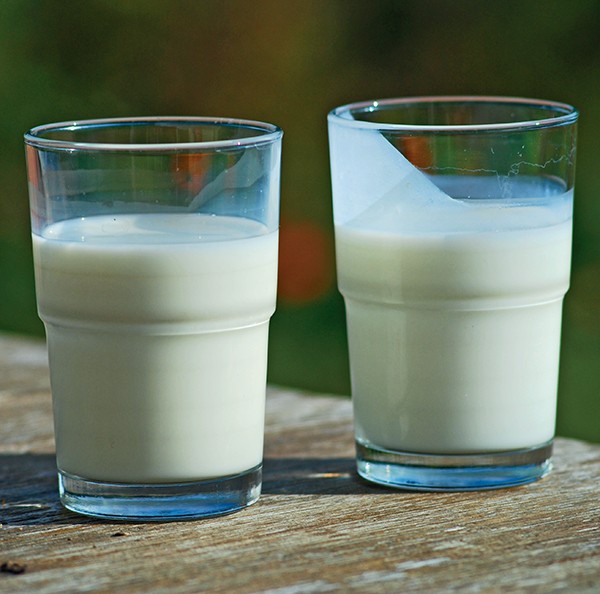
Photo: Stock image.
Milk has always been one of Ireland’s strongest natural resources and raw or unpasteurised milk has long been recognised as a complete and nutritionally balanced food.
This highly regarded ‘white blood’ was traditionally used as medicine until just after World War II. Raw milk is rich in vitamins and contains many beneficial bacteria, enzymes, amino acids and essential Omega 3 fats. It has been scientifically proven to reduce Asthma, Hayfever and Eczema and boost the immune system generally.
However, not all milk is produced equally: pasteurised milk has become big business since the late 1800s, and was initially introduced as a means of extending the shelf-life of milk. Pasteurisation was then further developed to eliminate various milk-borne pathogens found in raw milk, such as Tuberculosis, Campylobacter, Salmonella and E-Coli.
The Food Safety Authority of Ireland (FSAI) is of the opinion that raw milk is dangerous and should be avoided due to widespread concerns over these milk-borne illnesses. Over the last few years there has been a ‘Raw Milk Campaign’ which lobbied strongly, and successfully, to prevent the government from banning raw milk due to public health concerns.
In early 2013, the Government stated they would not issue an outright ban on raw milk but would introduce regulations governing its production and sale. The FSAI however, maintains their recommendation to consumers that “drinking raw milk can pose health risks to consumers and in some cases result in serious diseases”. The European Food Safety Authority recently stated that implementing current good hygiene practices at farms was essential in reducing raw milk contamination. Although illnesses from raw milk have dramatically decreased over the years, there have still been 27 outbreaks between 2007 and 2013.
Although raw milk cannot provide the same safety guarantee that pasteurised milk can, there is still a very big demand for it – some people want it for its health benefits, some for its great creamy taste and some because they and their ancestors grew up on it. Pasteurised milk does not offer a full safety guarantee either – it has been connected to Autism, type 1 Diabetes and allergies and it has also been intimated that milk producers are hiding behind bad practice by killing off pathogens in their milk post-facto. In August 2010 it was reported that DeCosters – dairy farmers in Iowa, USA were responsible for over 62,000 people contracting Salmonella.
The media has taught us over the years that dairy is our primary source of Calcium and that our teeth and bones can only grow healthily if we drink cow’s milk. Pasteurisation involves heating milk for a period of time to kill pathogenic bacteria. The problem here is a lot of the nutrients naturally found in milk are also destroyed in the process. One of the enzymes destroyed during the pasteurisation process is Phosphatase, which is essential for the absorption of Calcium.
If pasteurised milk was such a good solid source of Calcium, shouldn’t we be experiencing very low levels of osteoporosis? African Bantu women eat almost no dairy products at all, their Calcium intake is mainly from plant sources and they typically have up to 10 children each. Yet osteoporosis is virtually unheard of.
Many researchers and food standards experts believe that the quality and nutritional content of milk depends on the health of the cow and how it is reared. They state that milk pathogens originate primarily as a result of poor sanitation, animal stress and sickness. Today’s ‘Concentrated Animal Feeding Operations’, where cows are confined to small spaces and fed constantly with no exercise and no access to natural vegetation or light, surely exposes them to infections and environmental stress.
With the addition of hormones to control the cows’ ovulation cycles for frequent, shorter calving cycles and antibiotics for disease, there is no doubt that our milk is adulterated and it seems a far cry from the original product straight from the udder. Cows need to be clean, grass-fed, outdoors and healthy.
Raw or unpasteurised milk is clearly a controversial issue but whatever side of the fence you are on, I do believe we should have the freedom of choice as consumers to be able to purchase either raw or pasteurised milk – just as it should be the farmer’s choice to produce it. If you embark on a raw milk quest, ensure the farm is well-run with good hygiene standards and healthy grass-fed cows. Can’t access raw milk? Try almond, oat or rice milk – at least you won’t need to worry about those being injected with growth hormones!
Fundamentally, this debate begs the question: Is milk now merely another industrialised product and if so, are we being deprived of a significant natural resource? Is this the ultimate example of the industrialisation of nature?
Nicky is a Naturopathic Nutritionist practising in Dublin. She writes, speaks and advises nationwide on all aspects of health, nutrition and wellbeing. Check www.nickyflood.com for further info, upcoming courses and workshops.
By Nicky Flood

